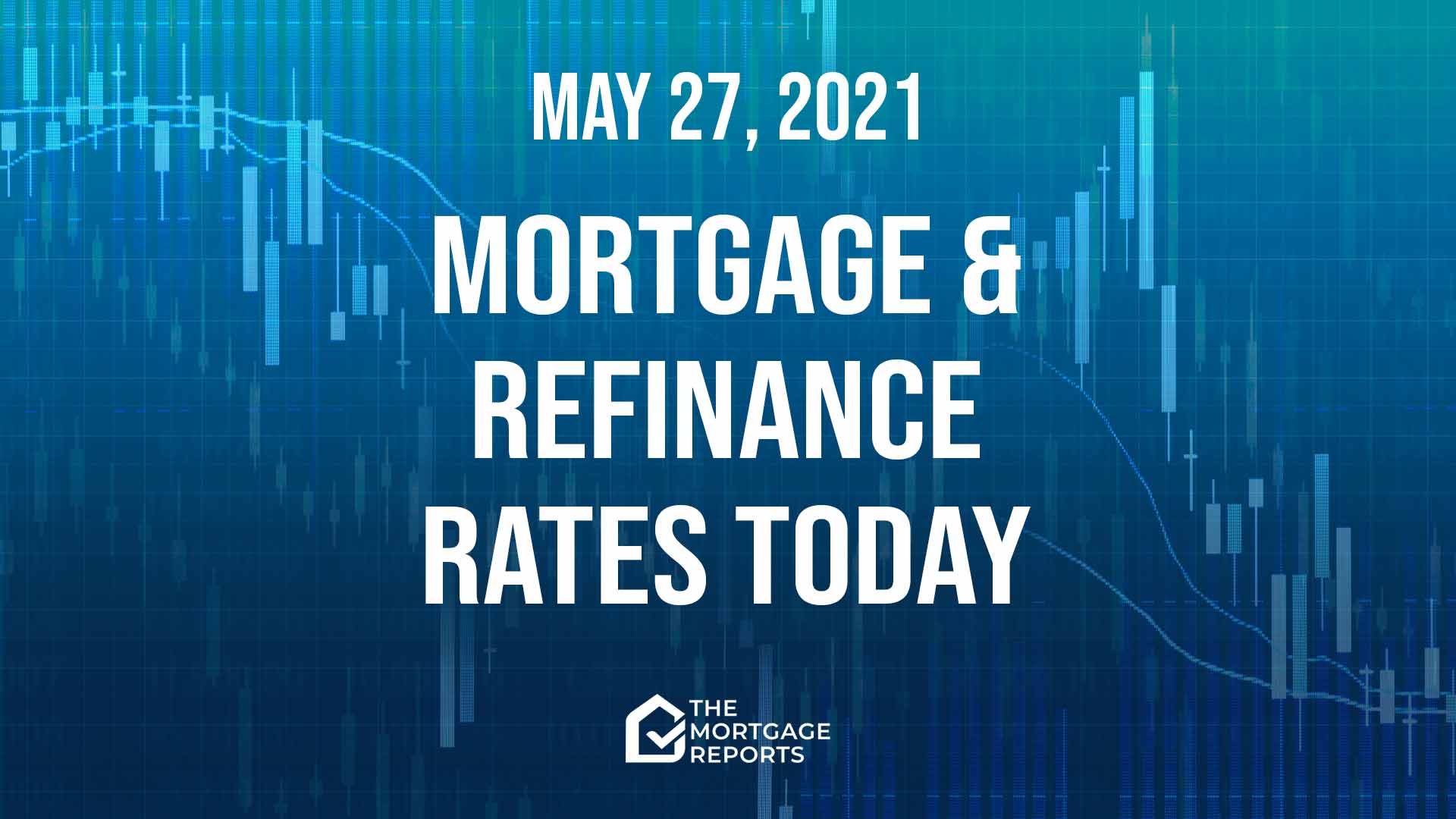
Today’s mortgage and refinance rates
Average mortgage rates inched lower yesterday. That makes four consecutive business days of falls: three small ones and a more worthwhile one.
Unfortunately, that great run may be coming to an end. Because mortgage rates today look likely to head higher.
Find and lock a low rate (May 27th, 2021)Current mortgage and refinance rates
| Program | Mortgage Rate | APR* | Change |
|---|---|---|---|
| Conventional 30 year fixed | |||
| Conventional 30 year fixed | 2.918% | 2.925% | -0.07% |
| Conventional 15 year fixed | |||
| Conventional 15 year fixed | 2.17% | 2.195% | -0.11% |
| Conventional 20 year fixed | |||
| Conventional 20 year fixed | 2.75% | 2.769% | -0.07% |
| Conventional 10 year fixed | |||
| Conventional 10 year fixed | 1.947% | 2.013% | Unchanged |
| 30 year fixed FHA | |||
| 30 year fixed FHA | 2.747% | 3.405% | Unchanged |
| 15 year fixed FHA | |||
| 15 year fixed FHA | 2.436% | 3.037% | Unchanged |
| 5 year ARM FHA | |||
| 5 year ARM FHA | 2.5% | 3.188% | Unchanged |
| 30 year fixed VA | |||
| 30 year fixed VA | 2.335% | 2.507% | +0.05% |
| 15 year fixed VA | |||
| 15 year fixed VA | 2.25% | 2.571% | Unchanged |
| 5 year ARM VA | |||
| 5 year ARM VA | 2.5% | 2.366% | Unchanged |
| Rates are provided by our partner network, and may not reflect the market. Your rate might be different. Click here for a personalized rate quote. See our rate assumptions here. | |||
COVID-19 mortgage updates: Mortgage lenders are changing rates and rules due to COVID-19. To see the latest on how coronavirus could impact your home loan, click here.
Should you lock a mortgage rate today?
My personal rate lock recommendations have been stuck on Lock for a while. That’s because I’m fairly convinced that mortgage rates are going to rise soon. The trouble is, I don’t know how soon. And neither does anyone else.
That means we’ll have periods of falls until rates begin to climb again — and a few after that. So don’t feel obliged to lock on days when rates look likely to fall. It may be smarter to wait until they begin to rise.
But be sure to check with your lender that you’ll be OK to lock when the moment comes. And keep a close eye on mortgage rates in the meantime.
So my personal, overall rate lock recommendations must remain:
- LOCK if closing in 7 days
- LOCK if closing in 15 days
- LOCK if closing in 30 days
- LOCK if closing in 45 days
- LOCK if closing in 60 days
However, I don’t claim perfect foresight. And your personal analysis could turn out to be as good as mine — or better. So you might choose to be guided by your instincts and your personal tolerance for risk.
Market data affecting today’s mortgage rates
Here’s a snapshot of the state of play this morning at about 9:50 a.m. (ET). The data, compared with roughly the same time yesterday, were:
- The yield on 10-year Treasurys rose to 1.62% from 1.56%. (Bad for mortgage rates.) More than any other market, mortgage rates normally tend to follow these particular Treasury bond yields, though less so recently
- Major stock indexes were mostly higher on opening. (Bad for mortgage rates.) When investors are buying shares they’re often selling bonds, which pushes prices of those down and increases yields and mortgage rates. The opposite may happen when indexes are lower
- Oil prices climbed to $66.35 from $65.75 a barrel. (Bad for mortgage rates*.) Energy prices play a large role in creating inflation and also point to future economic activity.
- Gold prices fell to $1,895 from $1,906 an ounce. (Neutral for mortgage rates*.) In general, it’s better for rates when gold rises, and worse when gold falls. Gold tends to rise when investors worry about the economy. And worried investors tend to push rates lower
- CNN Business Fear & Greed index — increased to 39 from 35 out of 100. (Bad for mortgage rates.) “Greedy” investors push bond prices down (and interest rates up) as they leave the bond market and move into stocks, while “fearful” investors do the opposite. So lower readings are better than higher ones
Caveats about markets and rates
Before the pandemic and the Federal Reserve’s interventions in the mortgage market, you could look at the above figures and make a pretty good guess about what would happen to mortgage rates that day. But that’s no longer the case. We still make daily calls. And are usually right. But our record for accuracy won’t achieve its former high levels until things settle down.
So use markets only as a rough guide. Because they have to be exceptionally strong or weak to rely on them. But, with that caveat, so far mortgage rates today look likely to rise. However, be aware that intraday swings (when rates change direction during the day) are a common feature right now.
Find and lock a low rate (May 27th, 2021)
Important notes on today’s mortgage rates
Here are some things you need to know:
- Typically, mortgage rates go up when the economy’s doing well and down when it’s in trouble. But there are exceptions. Read ‘How mortgage rates are determined and why you should care
- Only “top-tier” borrowers (with stellar credit scores, big down payments and very healthy finances) get the ultralow mortgage rates you’ll see advertised
- Lenders vary. Yours may or may not follow the crowd when it comes to daily rate movements — though they all usually follow the wider trend over time
- When daily rate changes are small, some lenders will adjust closing costs and leave their rate cards the same
- Refinance rates are typically close to those for purchases. But some types of refinances are higher following a regulatory change
So there’s a lot going on here. And nobody can claim to know with certainty what’s going to happen to mortgage rates in coming hours, days, weeks, or months.
Are mortgage and refinance rates rising or falling?
Today and soon
Yesterday, I wrote that Federal Reserve “… Vice Chair for Supervision Randal Quarles is due to speak this afternoon and will almost certainly take a similar line,” with that line being that the Fed has inflation firmly under control. Sorry, I was wrong.
Because, according to yesterday’s Wall Street Journal:
The Federal Reserve’s point man on financial regulation, Randal Quarles, said Wednesday that if the U.S. economy turns in the strong performance he now expects, the door will soon open to a debate about slowing the pace of the central bank’s bond-buying stimulus.
— WSJ, “Fed’s Quarles Joins Other Officials in Moving Toward Taper Debate” (Paywall), May 26, 2021
Also yesterday, Clinton-era treasury secretary and top Obama economic adviser Larry Summers weighed in with his own concerns:
The Fed’s idea used to be that it removed the punchbowl before the party got good. Now, the Fed’s doctrine is that it will only remove the punchbowl after it sees some people staggering around drunk.
Inflation fears won’t go away
These remarks are important because they fuel fears among investors that the Fed and the White House are crossing their fingers and hoping for the best over inflation. Because, right now, Mr. Quarles represents a minority of that organization’s leaders. And the official line is that rising prices are merely transitory.
All this matters. Because, if enough investors believe that the Fed’s wrong, that’s highly likely to push up mortgage rates, possibly sharply and for a long time to come.
Right now, the Fed is buying assets (mostly bonds) at a rate of $120 billion each month. And many (about one-third) of those bonds are mortgage-backed securities, the prices of which actually determine mortgage rates.
Its purchases are currently keeping those rates artificially low. So, if it’s forced to reduce its buying spree unexpectedly soon, that’s almost inevitably going to lead to higher — perhaps much higher — mortgage rates.
Mortgage rates and inflation: Why are rates going up?
For more background, check out our latest weekend edition of this report.
Recently — Updated today
Over much of 2020, the overall trend for mortgage rates was clearly downward. And a new, weekly all-time low was set on 16 occasions last year, according to Freddie Mac.
The most recent weekly record low occurred on Jan. 7, when it stood at 2.65% for 30-year fixed-rate mortgages. But then the trend reversed and rates rose.
However, those rises were mostly replaced by falls in April, though those moderated during the second half of that month. Meanwhile, May has so far seen falls outweighing rises, though only slightly. Freddie’s May 27 report puts that weekly average at 2.95% (with 0.6 fees and points), down from the previous week’s 3.0%.
Expert mortgage rate forecasts
Looking further ahead, Fannie Mae, Freddie Mac and the Mortgage Bankers Association (MBA) each has a team of economists dedicated to monitoring and forecasting what will happen to the economy, the housing sector, and mortgage rates.
And here are their current rates forecasts for the remaining quarters of 2021 (Q2/21, Q3/21, Q4/21) and the first quarter of 2022 (Q1/22).
The numbers in the table below are for 30-year, fixed-rate mortgages. Fannie’s were updated on May 19 and the MBA’s on May 21. Freddie’s forecast is dated April 14. But it now updates only quarterly. So expect its numbers to begin to look stale soon.
| Forecaster | Q2/21 | Q3/21 | Q4/21 | Q1/22 |
| Fannie Mae | 3.0% | 3.1% | 3.2% | 3.3% |
| Freddie Mac | 3.2% | 3.3% | 3.4% | 3.5% |
| MBA | 3.1% | 3.3% | 3.5% | 3.7% |
However, given so many unknowables, the current crop of forecasts might be even more speculative than usual.
Find your lowest rate today
Some lenders have been spooked by the pandemic. And they’re restricting their offerings to just the most vanilla-flavored mortgages and refinances.
But others remain brave. And you can still probably find the cash-out refinance, investment mortgage or jumbo loan you want. You just have to shop around more widely.
But, of course, you should be comparison shopping widely, no matter what sort of mortgage you want. As federal regulator the Consumer Financial Protection Bureau says:
Verify your new rate (May 27th, 2021)Shopping around for your mortgage has the potential to lead to real savings. It may not sound like much, but saving even a quarter of a point in interest on your mortgage saves you thousands of dollars over the life of your loan.



